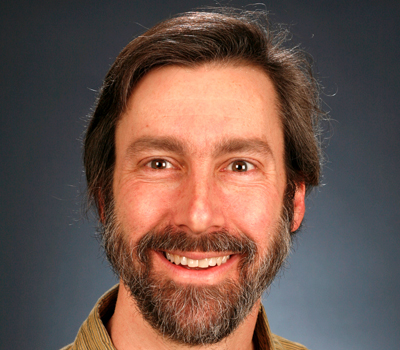Maps of the cosmos provide new insights about dark energy and galaxy formation
Can you recall looking into the sky on a clear, dark night? Perhaps you were awed by the fullness of the moon, the sparkling of innumerable stars, or the faint glow of the Milky Way. It doesn't take long for the magnitude of the night sky to inspire searching questions. How old is the universe? How did it begin? How far does it go? What is it made of? How will it end? Dr. David Weinberg, of Ohio State University, studies the formation of cosmic structure, investigating how the universe went from being full of smoothly distributed hot gas to being filled with galaxies and giant structures of galaxies that extend to hundreds of millions of light years. His research addresses some of humanity's most ancient questions, once the subject of philosophical speculation but now firmly in the realm of empirical science. These questions, and the search for answers, inspire new generations of scientists, including Dr. Weinberg's ever-growing family of former students.
A central goal of Dr. Weinberg's research is to understand why the expansion of the universe is speeding up instead of slowing down. The startling phenomenon of cosmic acceleration, discovered in the 1990s, is the deepest mystery of contemporary cosmology, implying that even "empty" space is filled by an exotic "dark energy" that exerts repulsive gravity. With precise measurements from enormous cosmological surveys, Dr. Weinberg and his collaborators aim to pin down the properties of dark energy and explain why it pervades the cosmos. The complementary goal of Dr. Weinberg's work is to trace the history of galaxy formation, from tiny fluctuations of dark matter in the infant universe through to the giant pinwheels of stars that are the basic element of structure in the universe today. Much of this work uses supercomputer simulations to calculate the effects of gravity and star formation in an expanding theoretical universe, or applies sophisticated statistical techniques to compare these calculations to the cosmos we observe. These theoretical studies are aimed squarely at the interpretation of astronomical data, and Dr. Weinberg has played leading roles in the Sloan Digital Sky Survey, which has created the largest ever maps of the distant universe and of our own Milky Way galaxy. Dr. Weinberg also serves on the Science Definition Team for the Wide Field Infrared Survey Telescope, which is expected to become NASA's major new astrophysics space mission of the 2020s.
In addition to his scientific investigations, Dr. Weinberg is attentive to his students at Ohio State University, from non-scientist undergraduates seeking a glimpse of modern cosmology through to his doctoral and postdoctoral advisees, many of whom are now leading researchers in their own right and training their own new generations of students. Dr. Weinberg founded Ohio State's world-renowned "astro coffee," where dozens of students, postdocs, and faculty gather every weekday for an intense 30-minute discussion of the day's most interesting astronomy articles. Dr. Weinberg is drawn to research because of his desire to understand how the universe works, and in his quarter-century as a cosmologist he has seen many profound questions resolved by the combination of new data and powerful computer simulations. In addition to the questions themselves, he loves "the way we learn about the universe in astronomy, using theories to inspire our strategies of observation, and observational discoveries that settle some theoretical questions while opening new ones."
Current research includes:
-
Decoding the Clustering of Galaxies: Dr. Weinberg and his team use 3-dimensional maps from the Sloan Digital Sky Survey to measure the expansion history of the universe and the pace with which it is forming new structure. With these measurements, they probe the causes of cosmic acceleration and test whether Einstein's theory of gravity breaks down on cosmological scales.
-
Mapping the Past: Dr. Weinberg uses intergalactic hydrogen to map cosmic structures more than 10 billion light years from Earth, revealing the state of the universe during the first few billion years of cosmic history. He and his team use computer simulations to interpret these maps, tying them to the underlying distribution of dark matter and the environments of quasars and young galaxies.
-
The History of the Milky Way: In addition to distant galaxies, the Sloan survey has mapped the distribution of individual chemical elements -- carbon, nitrogen, oxygen, silicon, iron, etc., -- for tens of thousands of stars throughout the Milky Way. Dr. Weinberg and his team are developing novel methods to interpret this vast collection of chemical fingerprints and tie the history of the Milky Way to the broader cosmological understanding of galaxy formation.
-
Supercomputer Simulations: Dr. Weinberg and his collaborators use computers to solve the equations that describe gravity, fluid dynamics, and star formation and thus predict the history of galaxy formation. By comparing their simulations to observations from Hubble Space Telescope, they hope to understand the fate of primordial gas that is pulled into galaxies by gravity but pushed out by explosions before being incorporated into stars.
Bio
As a child, Dr. Weinberg enjoyed math and math puzzles and soon became interested in physics, mainly through reading popular books. The first hook was the book, One, Two, Three, ... Infinity, by George Gamow, which started with imaginary numbers and progressed to relativity and subatomic physics. While studying Physics at Yale, Dr. Weinberg enrolled in an astronomy course and decided that astrophysics was the field he would like to pursue. He is drawn to questions that feel "fundamental," and he enjoys the close interaction between theoretical ideas and observations found in astrophysics. He also has come to appreciate the huge diversity of astronomical questions, from the cosmos to galaxies to stars to planets, and maybe even the life on other worlds.
Since trading ultimate frisbee for parenthood 11 years ago, Dr. Weinberg spends most of his free time with his family. He enjoys watching his daughter's basketball games, helping her learn the drums, and reading her books from Harry Potter to 20,000 Leagues Under the Sea. He runs when he can (more slowly every year), and he loves the landscape of southern Utah and the Alps.
Over the past decade, Dr. Weinberg has collaborated with artist Josiah McElheny on the design of cosmologically inspired sculptures (http://www.astronomy.ohio-state.edu/~dhw/McElheny/index.html), which have been exhibited in galleries and museums across the U.S. and Europe. He also served as the scientific script consultant for the film Dark Matter, starring Liu Ye, Aidan Quinn, and Meryl Streep, which won the Alfred P. Sloan Prize for a scientifically themed film at the 2007 Sundance Film Festival. His more offbeat endeavors include The Dark Matter Rap (http://www.astronomy.ohio-state.edu/~dhw/Rap), a rapid-fire 7-minute history of the dark matter problem that he still performs for his undergraduate cosmology students and the occasional dark matter conference.
Dr. Weinberg grew up in Arlington, Virginia and attended Sidwell Friends School in Washington, D.C. He remains an admirer of the Quaker commitment to education, peace, and social progress. His wife, Lisa Florman, is a Picasso and Kandinsky scholar and chair of Art History Department at Ohio State.


